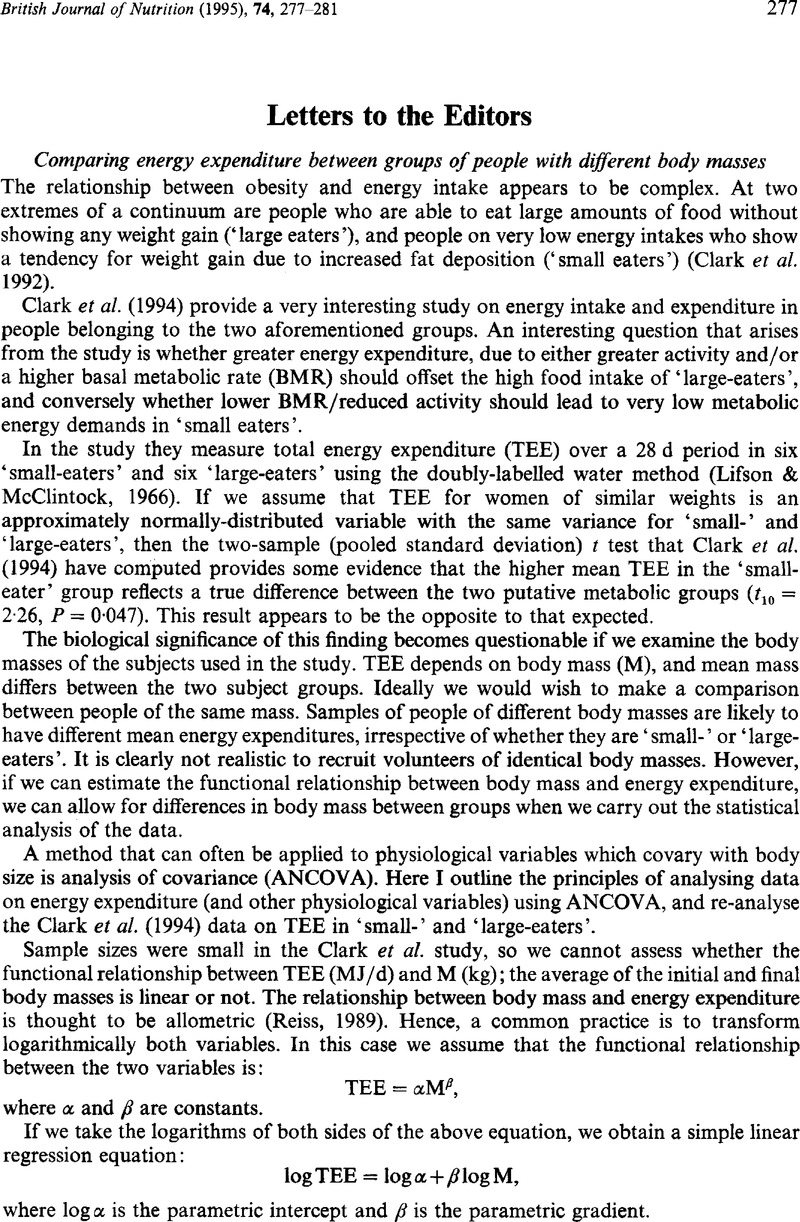No CrossRef data available.
Article contents
Letters to the Editors
Published online by Cambridge University Press: 09 March 2007
Abstract
An abstract is not available for this content so a preview has been provided. As you have access to this content, a full PDF is available via the ‘Save PDF’ action button.

- Type
- Letters to the Editors
- Information
- Copyright
- Copyright © The Nutrition Society 1995
References
REFERENCES
Clark, D., Tomas, F., Withers, R. T., Brinkman, M., Chandler, C., Philips, J., Ballard, F. J., Berry, M. & Nestel, P. (1992). Differences in energy metabolism between normal weight ‘large-eating’ and ‘small-eating’ women. British Journal of Nutrition 18, 31–44.CrossRefGoogle Scholar
Clark, D., Tomas, F., Withers, R. T., Chandler, C., Philips, J., Brinkman, M., Berry, M., Ballard, F. J. & Nestel, P. (1994). Energy metabolism in free-living, ‘large-eating’ and ‘small-eating’ women: studies using 2H218O. British Journal of Nutrition 72, 21–31.CrossRefGoogle ScholarPubMed
Lifson, N. & McClintock, R. (1966). Theory of use of the turnover rates of body water for measuring energy and material balance. Journal of Theoretical Biology 12, 46–74.CrossRefGoogle ScholarPubMed
Packard, G. C. & Boardman, T. J. (1988). The misuse of ratios, indices, and percentages in ecophysiological research. Physiological Zoology 61(1), 1–9.CrossRefGoogle Scholar
Reiss, M. J. (1989). The Allometry of Growth and Reproduction Cambridge, U.K.: Cambridge University Press.CrossRefGoogle Scholar
Clark, D. G., Tomas, F. M., Withers, R. T., Brinkman, M., Berry, M. N., Oliver, J. R., Owens, P. C., Butler, R. N., Ballard, F. J. and Nestel, P. J. (1995). Differences in substrate metabolism between self-perceived ‘large- eating’ and ‘small-eating’ women. International Journal of Obesity 19 (In the press.)Google ScholarPubMed
Clark, D., Tomas, F., Withers, R. T., Brinkman, M., Chandler, C., Phillips, J., Ballard, F. J., Berry, M. N. & Nestel, P. (1992). Differences in energy metabolism between normal weight ‘large-eating’ and ‘small-eating’ women. British Journal of Nutrition 68, 31–44.CrossRefGoogle ScholarPubMed
Clark, D., Tomas, F., Withers, R. T., Chandler, C., Brinkman, M., Phillips, J., Berry, M., Ballard, F. J. & Nestel, P. (1994). Energy metabolism in free-living, ‘large-eating’ and ‘small-eating’ women, studies using 2H218O. British Journal of Nutrition 72, 21–31.CrossRefGoogle ScholarPubMed
Clark, D., Tomas, F., Withers, R. T., Neville, S. D., Nolan, S. R., Brinkman, M., Chandler, C., Clark, C., Ballard, F. J., Berry, M. & Nestel, P. (1993). No major differences in energy metabolism between matched and unmatched groups of ‘large-eating’ and ‘small-eating’ men. British Journal of Nutrition 70, 393–406.CrossRefGoogle ScholarPubMed
Poehlman, E. T. & Horton, E. S. (1990). Regulation of energy expenditure in aging humans. Annual Review of Nutrition 10, 255–275.CrossRefGoogle ScholarPubMed
Ravussin, E. & Bogardus, C. (1989). Relationship of genetics, age, and physical fitness to daily energy expenditure and fuel utilisation. American Journal of Clinical Nutrition 49, 968–975.CrossRefGoogle Scholar
Schoeller, D. A., Ravussin, E., Schutz, Y., Acheson, K. J., Baertschi, P. & Jéquier, E. (1986). Energy expenditure by doubly labelled water: validation in humans and proposed calculation. American Journal of Physiology 250, R823–R830.Google ScholarPubMed


